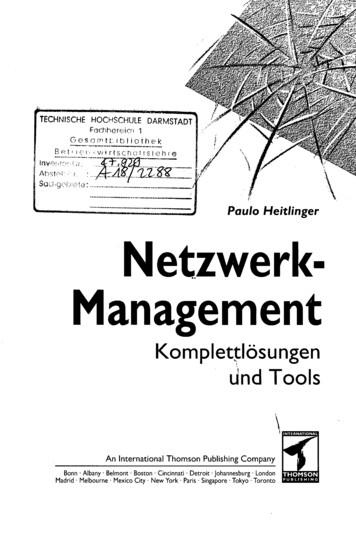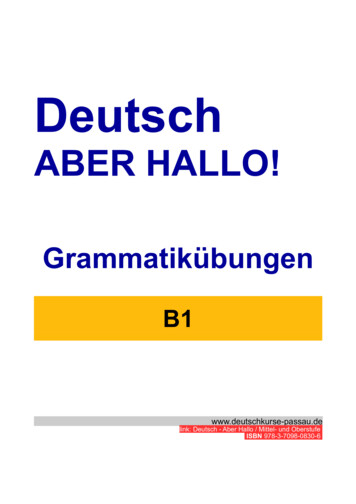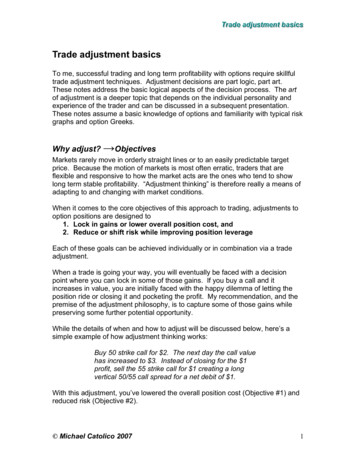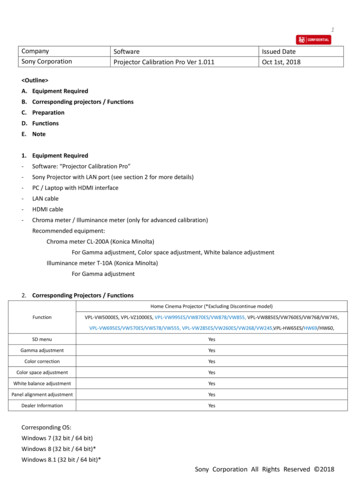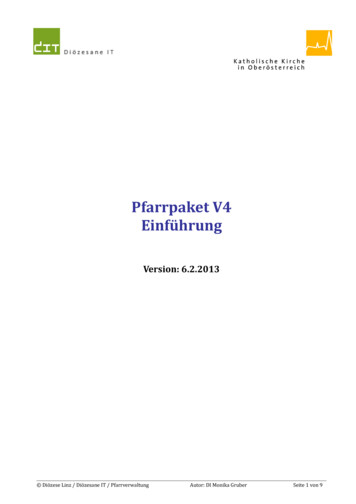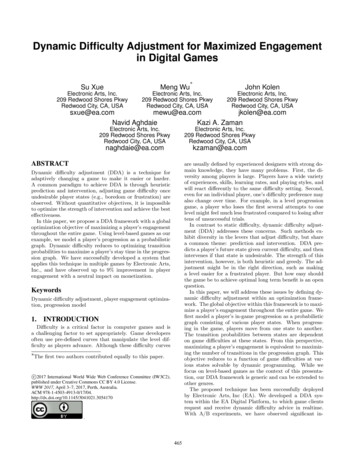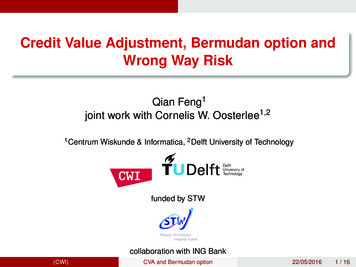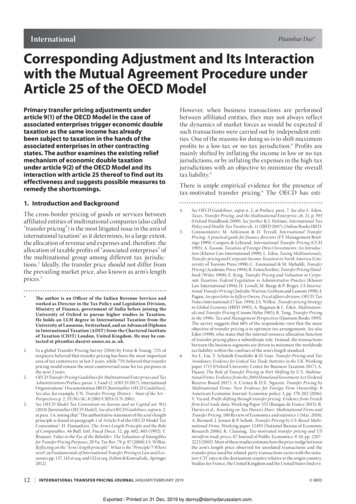
Transcription
InternationalPitambar Das*Corresponding Adjustment and Its Interactionwith the Mutual Agreement Procedure underArticle 25 of the OECD ModelPrimary transfer pricing adjustments underarticle 9(1) of the OECD Model in the case ofassociated enterprises trigger economic doubletaxation as the same income has alreadybeen subject to taxation in the hands of theassociated enterprises in other contractingstates. The author examines the existing reliefmechanism of economic double taxationunder article 9(2) of the OECD Model and itsinteraction with article 25 thereof to find out itseffectiveness and suggests possible measures toremedy the shortcomings.However, when business transactions are performedbetween affiliated entities, they may not always reflectthe dynamics of market forces as would be expected ifsuch transactions were carried out by independent entities. One of the reasons for doing so is to shift maximumprofits to a low-tax or no-tax jurisdiction.4 Profits aremainly shifted by inflating the income in low or no-taxjurisdictions, or by inflating the expenses in the high-taxjurisdictions with an objective to minimize the overalltax liability.5There is ample empirical evidence for the presence oftax-motivated transfer pricing.6 The OECD has esti-1. Introduction and BackgroundThe cross-border pricing of goods or services betweenaffiliated entities of multinational companies (also called“transfer pricing”) is the most litigated issue in the area ofinternational taxation1 as it determines, to a large extent,the allocation of revenue and expenses and, therefore, theallocation of taxable profits of “associated enterprises” ofthe multinational group among different tax jurisdictions.2 Ideally, the transfer price should not differ fromthe prevailing market price, also known as arm’s lengthprices.3*The author is an Officer of the Indian Revenue Services andworked as Director in the Tax Policy and Legislation Division,Ministry of Finance, government of India before joining theUniversity of Oxford to pursue higher studies in Taxation.He holds an LLM degree in International Taxation from theUniversity of Lausanne, Switzerland, and an Advanced Diplomain International Taxation (ADIT) from the Chartered Instituteof Taxation (CIOT) London, United Kingdom. He may be contacted at pitambar.das@st-annes.ox.ac.uk.1.In a global Transfer Pricing Survey (2016) by Ernst & Young, 72% oftaxpayers believed that transfer pricing has been the most importantarea of tax controversy in last 3 years, while 75% believed that transferpricing would remain the most controversial issue for tax purposes inthe next 2 years.OECD Transfer Pricing Guidelines for Multinational Enterprises and TaxAdministrations Preface, paras. 1.3 and 12. (OECD 2017), InternationalOrganizations’ Documentation IBFD [hereinafter OECD Guidelines].See also, for example, UN, Transfer Pricing: History – State of the Art –Perspectives p. 2, ST/SG/AC.8/2001/CRP.6 (UN 2001).See OECD Model Tax Convention on Income and on Capital art. 9(1)(2014) [hereinafter OECD Model]. See also OECD Guidelines, supra n. 2,at para. 1.6, noting that “The authoritative statement of the arm’s lengthprinciple is found in paragraph 1 of Article 9 of the OECD Model TaxConvention”; H. Hamaekers, The Arm’s Length Principle and the Roleof Comparables, 46 Bull. Intl. Fiscal Docn. 12, pp. 602, 603 (1992); Y.Brauner, Value in the Eye of the Beholder: The Valuation of Intangiblesfor Transfer Pricing Purposes, 28 Va. Tax Rev. 79, p. 97 (2008); J.S. Wilkie,Reflecting on the “Arm’s length principle”: What is the “Principle”? Wherenext?, in Fundamentals of International Transfer Pricing in Law and Economics pp. 137, 143 et seq. and 152 et seq. (Schön & Konrad eds., Springer2012).2.3.124.5.6.See OECD Guidelines, supra n. 2, at Preface, para. 7. See also L. Eden,Taxes, Transfer Pricing, and the Multinational Enterprise, ch. 21, p. 593(Oxford Handbook 2009). See further K.J. Holmes, International TaxPolicy and Double Tax Treaties ch. 11 (IBFD 2007), Online Books IBFD.Commentators: M. Aitkinson & D. Tyrrall, International TransferPricing: A practical guide for finance directors (FT Management Briefings 1999); Coopers & Lybrand, International Transfer Pricing (CCH1993); A. Easson, Taxation of Foreign Direct Investments: An Introduction (Kluwer Law International 1999); L. Eden, Taxing Multinationals,Transfer pricing and Corporate Income Taxation in North America (University of Toronto Press 1998); C. Emmanuel & M. Mehafdi, TransferPricing (Academic Press 1994); R. Feinschreiber, Transfer Pricing Handbook (Wiley 1998); E. King, Transfer Pricing and Valuation in Corporate Taxation: Federal Legislation vs Administrative Practice (KluwerLaw International 1994); H. Lowell, M. Burge & P. Briger, US International Transfer Pricing (2nd edn, Warren, Gorham and Lamont 1998); J.Pagan, An open letter to Jeffery Owens, Fiscal affairs division, OECD, TaxNotes International (17 Jan. 1994); J.S. Wilkie, Transfer pricing Strategyin Global Economy (IBFD 1995); A. Rugman & L. Eden, Multinationals and Transfer Pricing (Croom Helm 1985); R. Tang, Transfer Pricingin the 1990s: Tax and Management Perspectives (Quorum Books 1993).The survey suggests that 68% of the respondents view that the mainobjective of transfer pricing is to optimize tax arrangements. See alsoEden (1998), who states that the internal resource allocation functionof transfer pricing plays a subordinate role. Instead, the transactionsbetween the business segments are driven to minimize the worldwidetax liability within the confines of the arm’s length standard.See L. Liu, T. Schmidt-Eisenlohr & D. Guo, Transfer Pricing and TaxAvoidance: Evidence for Linked Tax Trade Statistics in the UK, Workingpaper 1715 (Oxford University Centre for Business Taxation 2017); A.Flaaen, The Role of Transfer Pricing in Port-Shifting by U.S. Multinational Firms: Evidence from the 2004 Homeland Investment Act (FederalReserve Board 2017); A. Cristea & D.X. Nguyen, Transfer Pricing byMultinational Firms: New Evidence for Foreign Firm Ownership, 8American Economic Journal: Economic policy 3, pp. 170-202 (2016);V. Vicard, Profit shifting through transfer pricing: Evidence from Frenchfirm level trade data, Working Paper 555 (Banque de France 2015); R.Davies et al., Knocking on Tax Haven’s Door: Multinational Firms andTransfer Pricing, 100 Review of Economics and statistics 1 (Mar. 2018);A. Bernard, J. Jensen & P. Schott, Transfer Pricing by US-Based Multinational Firms, Working paper 12493 (National Bureau of EconomicResearch 2006); K. Clausing, Tax-motivated transfer pricing and USintrafirm trade prices, 87 Journal of Public Economics, 9-10, pp. 22072223 (2003). Most of these studies estimate how the price wedge betweenthe arm’s length price observed for unrelated transactions and thetransfer price used for related-party transactions varies with the statutory CIT rates in the destination country relative to the origin country.Studies for France, the United Kingdom and the United States find evi-International Transfer Pricing Journal January/February 2019 Exported / Printed on 31 Dec. 2019 by danny@dannydarussalam.com. IBFD
Corresponding Adjustment and Its Interaction with the Mutual Agreement Procedure under Article 25 of the OECD Modelmated that governments lose between USD 100 billion to240 billion annually in global corporate tax revenues dueto tax base erosion and profit shifting (BEPS) relating tointernational business transactions.7In order to protect the tax base of the different jurisdictions, article 9(1) of the OECD Model requires that thetransfer price for goods or services between the associatedenterprises must be at arm’s length,8 i.e. the price independent parties would charge for the same or similar transactions under the same or similar circumstances.9 The arm’slength principle remains the globally accepted standardin the area of international taxation.10 In a situation wherethe price charged for the goods transferred or services rendered is not in accordance with the arm’s length principle, the tax authorities make some adjustments (calledprimary adjustments)11 to the transfer price adopted bythe related entities to bring the price at par with the arm’slength principle.12 This may trigger economic double taxation13 as the same income may have already been subjectto taxation in the hands of the associated enterprises inthe other contracting state.In order to mitigate the economic double taxation causedby the application of article 9(1), article 9(2) requiresthe other tax jurisdiction to carry out a correspondingadjustment14 in the hands of the associated enterprises bydownward adjustment of its tax liability so that allocation of profits between two jurisdictions becomes consistent with primary adjustment and no double taxationoccurs.15 Therefore, the effective operation of corresponding adjustments as per article 9(2) of the OECD Model isthe key for eliminating economic double taxation in thecase of a transfer pricing adjustment. Article 9(2) specifically provides that the competent authorities shall consulteach other if necessary to determine the appropriate corresponding adjustments.16 The bilateral consultationhappens only by way of a mutual agreement procedure7.8.9.10.11.12.13.14.15.16.dence for significant response of the price wedge to the tax rate differential as supportive evidence for tax-motivated transfer mispricingby the MNCs.OECD, Top 10 FAQs About BEPS, available at uestions-about-beps.pdf (accessed 6Nov. 2018).See art. 9(1) OECD Model; K. Vogel, in Klaus Vogel on Double TaxationConventions – Fourth Edition p. 594 (E. Reimer & A. Rust eds., KluwerLaw International 2015).Vogel, supra n. 8, at p. 638.Vogel, supra n. 8, at p. 594.Primary adjustment, in OECD Glossary of Tax Terms. The OECD Guidelines define the primary adjustment as an adjustment made by the taxauthorities in the price declared by the taxpayer to bring the price at parwith the arm’s length principle.Vogel, supra n. 8, at p. 596. See also art. 9(2) OECD Model.See para. 2 OECD Model: Commentary on Article 23A and 23B. It defineseconomic double taxation as the imposition of comparable taxes in twoor more countries in respect of the same income or capital for an identical period. See also para. 5 OECD Model: Commentary on Article 9.Corresponding adjustment, in OECD Glossary of Tax Terms. The OECDGuidelines define corresponding adjustment as an adjustment to thetax liability of associated enterprises in the second tax jurisdiction corresponding to the primary adjustment made by the tax administrationof the first state, so that allocation of profits of two jurisdictions areconsistent.See OECD Guidelines, supra n. 2, at para. 4.32.See art. 9(2) OECD Model. See also OECD Guidelines, supra n. 2, at para.4.33, as per which article 9(2) confirms that the MAP of art. 25 may beused to consider corresponding adjustments. IBFD (MAP) under article 25.17 Even the OECD Commentaryon Article 25 states that corresponding adjustments to bemade in pursuance of article 9(2) fall within the scopeof the MAP.18 However, in a significant number of cases,the tax jurisdictions fail to provide corresponding adjustments effectively (reasons are detailed in subsequent paragraphs) resulting in economic double taxation. As perthe global transfer pricing survey conducted by Ernst& Young, about 47% of the parent companies reportedthe occurrence of double taxation as a result of a transferpricing audit.19The Ernst & Young Global Transfer Pricing Survey (2016)reveals that 79% of the taxpayers believe that post-BEPSimplementations would make settlement of transferpricing disputes difficult and more time consuming.20This would mean a substantial increase in economicdouble taxation cases relating to transfer pricing adjustments in the future. According to the Ernst & YoungGlobal Transfer Pricing Survey (2016), transfer pricinghas entered into an era of heightened tax risk and controversy. The survey reveals that “tax risk management”is the top priority in the case of 75% of taxpayers as compared to 66% in 2013 and 50% in 2007 and 2010.21 In mostof the jurisdictions, the transfer pricing adjustments resultin a levy of interest 22 and penalty23 adding to the cost ofoperation for the multinational companies, which in turnaffects the international trade and investments.2. Impact of Transfer Pricing on InternationalTax Policy: Empirical EvidenceThe basic purpose of international tax policy as embodiedin tax treaties is to avoid double taxation, both juridicaland economic, and to prevent fiscal evasion while promoting international trade and investment.24 However, one ofthe most visible obstacles to cross-border trade and investment is the double taxation of foreign income.25Several empirical studies have been conducted byresearchers to establish a relation between double taxation and foreign direct investment (FDI). The empiricalstudies conducted by Barthel et al. (2010) have revealedthat the presence of effective double tax treaties increases17.18.19.20.21.22.23.24.25.See art. 25 OECD Model. See also para. 2 OECD Model: Commentary onArticle 25.See para. 10 OECD Model: Commentary on Article 25. See also para. 2OECD Model: Commentary on Articles 23A and 23B.Ernst & Young, Navigating the choppy waters of international tax – 2013Global Transfer Pricing Survey (EY 2013). See also Ernst & Young, 2014global transfer pricing tax authority survey – Perspectives, interpretationsand regulatory change (EY 2014).Ernst & Young, 2016 Transfer Pricing Survey Series – In the spotlight: Anew era of transparency and risk p. 7 (2016).Id., at p. 3.Id., at p. 9. It states that interest was levied in 39% of the cases which aresubject to a transfer pricing audit.Id., at p. 8. It states that 16% of the transfer pricing audit cases are subjectto the levy of a penalty.See Preamble OECD Model. The original version of the OECD Modeldid not contain the prevention of fiscal evasion as its objective. Thisphrase was added in the 1992 version of the OECD Model for the firsttime.See P. Egger et al., The Impact of Endogenous Tax Treaties on ForeignDirect Investment: Theory and Evidence, 39 Canadian Economic Journal3, pp. 901-931 (2006).International Transfer Pricing Journal January/February 2019Exported / Printed on 31 Dec. 2019 by danny@dannydarussalam.com.13
Pitambar Dasthe bilateral FDI stock between 27% and 31%.26 Neumayer(2007),27 through empirical study, had estimated the effectof double tax treaties on the flow of FDI to developingcountries. He finds that the existence of a double tax treatyis associated with a 22% higher FDI outbound stock. Byand large, the findings of empirical researches have established a positive relation between the presence of an effective double tax treaty and the flow of FDI. In other words,effective elimination of double taxation would result inmore investment.28The OECD, 29 in its study on the effect of tax on the flow ofFDI, has found that on average, FDI decreases by 3.7 percentage point following a 1 percentage point increase inthe tax rate on FDI. Therefore, in order to promote international trade and investment, it is imperative to mitigatedouble taxation.Empirical studies have also revealed that transfer pricingmanipulation may be one of the most common methodsused by multinational companies to shift profit fromhigh-tax jurisdictions to low-tax jurisdictions.30 Accordingly, the countries have adopted transfer pricing regulations in order to protect the domestic revenue base and tocurb potential unfair competition between domestic andmultinational firms.31 However, given that multinationalsare often more mobile than domestic firms, the potentialbenefits of anti-avoidance legislation could be undone ifmultinationals respond by cutting their investment andreducing their presence in the local economy.A recent empirical study conducted by the InternationalMonetary Fund (IMF)32 has revealed that investment inforeign affiliates is reduced on an average by 11% becauseof the transfer pricing regulations, compared to investment in similar firms that are wholly domestic. The reduction in investment is larger if transfer pricing regulationsare stricter. These findings of empirical research areextremely relevant in the present context. If the economicdouble taxation pursuant to transfer pricing adjustments26.27.28.29.30.31.32.14See F. Barthel, M. Busse & E. Neumayer, The impact of Double TaxationTreaties on Foreign Direct Investment: Evidence from large dyadic paneldata, 28 Contemporary Economic Policy 3, pp. 366-377 (2010).See E. Neumayer, Do Double Taxation Treaties Increase Foreign DirectInvestment to Developing Countries?, 43 Journal of development Studies8, pp. 1501-1519 (2007).P. Egger & V. Merlo, The Impact of Bilateral Investment Treaties on FDIDynamics, 30 The World Economy 10, pp. 1536-1549 (2007). See alsoB.A. Blonigen & R.B. Davies, Do Bilateral Tax Treaties Promote ForeignDirect Investments?, in Handbook of International Trade – Volume II, pp.526-546 (E.K. Choi & J.C. Hartigan eds., Blackwel 2005).OECD, Tax Effects on Foreign Direct Investment (OECD 2008).Clausing, supra n. 6.C. Fuest et al., Profit Shifting and ‘Aggressive’ Tax Planning by Multinational Firms: Issues and Options for Reform, ZEW Discussion Papers13-044 (2013).R.A. de Mooij & L. Liu., At a Cost: The Real Effect of Transfer Pricing Regulations, IMF Working Paper (2017). This paper uses panel data on morethan 250,000 companies in 60 countries over the years 2006-2015 toempirically investigate whether the transfer pricing rules reduce investment by multinational firms. See also M. Keen, Preferential RegimesCan Make Tax Competition Less Harmful, 54 National Tax Journal 4,pp. 757-762 (2001); J. Eckhard & M. Smart, Is Targeted Tax Competition Less Harmful Than Its Remedies?, 10 International Tax and PublicFinance 3, pp. 259-280 (2003); S. Bucovetsky & A. Hauer, PreferentialTax Regimes With Asymmetric Countries, 60 National Tax Journal 4,pp. 789-795 (2007).in one contracting state is not eliminated by the other contracting state, there would be additional cost to the multinational group leading to an adverse effect on international trade and investment, which would be a situationin contradiction to international tax policy as embodiedin tax treaties.3. Scope of this PaperTransfer pricing has a potential for profit shifting anderosion of the tax base. In order to curb BEPS, transferpricing regulations, as an anti-abuse rule, are used in mostcountries. However, as per theoretical and empirical evidence, in a large number of cases the transfer pricingadjustments have resulted in economic double taxation.Empirical studies reveal that double taxation is an obstacleto international trade and investment, thereby adverselyaffecting the basic objective of double tax treaties. Thismakes a strong case for revisiting the existing relief mechanism under the OECD Model for eliminating economicdouble taxation pursuant to transfer pricing adjustments.Therefore, when it is imperative to apply transfer pricingrules to protect the tax base, it is also necessary to eliminate economic double taxation arising out of transferpricing adjustments.This article examines the existing relief mechanism foreconomic double taxation under the OECD Model andfinds out its effectiveness to mitigate the same. At the end,it suggests possible remedial measures to overcome theshortcomings.4. Relief of Economic Double Taxation Relatingto Transfer Pricing Adjustments under theOECD Model4.1. Scope of article 9(2) of the OECD ModelArticle 9(2) of the OECD Model deals with mitigationof economic double taxation by way of a corresponding adjustment.33 In a case where one tax administrationincreases the taxable profit of a company by making aprimary adjustment as a result of applying the arm’s lengthprinciple to transactions involving an associated enterprise in a second tax jurisdiction, a corresponding adjustment in such a case is in principle a downward adjustmentto the tax liability of that associated enterprise made by thetax administration of the second jurisdiction. The objective of a corresponding adjustment is to avoid double taxation through aligning the allocation of profits betweenthe two tax administrations consistent with the primaryadjustment.34The wording of article 9(2) of the OECD Model (by usingthe verb “Shall”) seems to imply that a contracting state isobliged to make an automatic corresponding adjustmentfollowing any primary adjustment by the other contracting state.35 However, the OECD Commentary on Article 9states that an adjustment is not automatically36 to be made33.34.35.36.OECD Guidelines, supra n. 2, at para. 4.32.Id.See art. 9(2) OECD Model. See also Vogel, supra n. 8, at m.no. 113, p. 676.Para. 6 OECD Model: Commentary on Article 9.International Transfer Pricing Journal January/February 2019 IBFDExported / Printed on 31 Dec. 2019 by danny@dannydarussalam.com.
Corresponding Adjustment and Its Interaction with the Mutual Agreement Procedure under Article 25 of the OECD Modelin the second tax jurisdiction simply because the profitsin first tax jurisdiction have been increased. The obligation for a contracting state to make corresponding adjustments is limited to adjustments justified both in principleand amount.37 Therefore, there seems to be a mismatch ofthe scope of the corresponding adjustment between thewording used in article 9(2) of the OECD Model and theexplanation in the OECD Commentary on Article 9(2)and the OECD Guidelines.4.2. Methodology of corresponding adjustmentsArticle 9(2) of the OECD Model simply states that a corresponding adjustment38 may be required to be carried outin a second tax jurisdiction where the first tax administration increases the taxable profit of a company by making aprimary adjustment as a result of applying the arm’s lengthprinciple to transactions that involve an associated enterprise in a second tax jurisdiction and that are taxed inthat jurisdiction in order to mitigate economic doubletaxation. However, neither the said article nor any otherarticles of the OECD Model prescribe any methodologyto carry out the corresponding adjustment for relievingeconomic double taxation39 unlike in cases of juridicaldouble taxation, where article 23 expressly provides for anautomatic mechanism for relief of double taxation. Article9(2) further provides that the competent authorities shallconsult each other if necessary to determine appropriatecorresponding adjustments.40 The bilateral consultationhappens only by way of a MAP under article 25.41However, the OECD Commentary on Article 9 stipulates that the corresponding adjustment would be giventhrough bilateral measures.42 This confirms that the MAPunder article 25 may be used to consider correspondingadjustments.43 Further, the OECD Commentary on Articles 23A and 23B of the OECD Model states that the economic double taxation must be resolved by way of bilateral negotiation,44 which means by a MAP under article25 of the OECD Model.45 The OECD Guidelines also stipulate that the corresponding adjustments are to be undertaken by a MAP under article 25 of the OECD Model.46However, some OECD member countries prefer toprovide corresponding adjustments under article 23 of the37.38.39.40.41.42.43.44.45.46.Id.OECD Guidelines, supra n. 2, at para. 4.32.See para. 6 OECD Model: Commentary on Article 9.See art. 9(2) OECD Model. See also OECD Guidelines, supra n. 2, at para.4.33, as per which art. 9(2) confirms that the mutual agreement procedure of art. 25 may be used to consider corresponding adjustments.See art. 25 OECD Model. See also para. 2 OECD Model: Commentary onArticle 25.Para. 7 OECD Model: Commentary on Article 9. However, as per art.25(2) OECD Model, a state can give corresponding adjustments by wayof a unilateral measure without meeting with the other contracting stateor formally arranging a bilateral MAP.OECD Guidelines, supra n. 2, at para. 4.33.See para. 2 OECD Model: Commentary on Articles 23A and 23B, concerning the methods of elimination of double taxation.See para. 10 OECD Model: Commentary on Article 25.Paras. 4.36 and 4.32 OECD Guidelines. See also paras. 11-12 OECDModel: Commentary on Article 25, which expressly state the view ofmost OECD member countries that the MAP is considered to apply totransfer pricing adjustment cases, including issues of whether corresponding adjustments should be provided. IBFD OECD Model47 even though article 23 of the OECD Modelis designed to prevent juridical double taxation, whichmeans the taxation of income or capital in the hands ofthe same taxpayer by more than one state.48 Therefore,under the present scheme of double tax agreements, theMAP under article 25 is the only method49 available todeal with economic double taxation in respect of transferpricing adjustments.Therefore, the effectiveness of the MAP plays a significant role in eliminating double taxation in the case oftransfer pricing adjustments. However, the effective application of a MAP in eliminating double taxation wouldlargely depend on compatibility of scope of the provisionsof article 9 with that of article 25 apart from other procedural aspects including its interaction with domesticlegal remedies. Alternatively, in case of incompatibility,the MAP may not be effective to relieve economic doubletaxation in transfer pricing adjustments.4.3. Scope of article 25 of the OECD ModelArticle 25 sets out three different areas where MAPs aregenerally used. The first area includes instances of “taxation not in accordance with the provisions of the conventions”.50 The other two areas deal with questions of“interpretation of or application of the convention” andelimination of double taxation in cases not otherwise provided for in the convention.51 Article 25(1) of the OECDModel requires the taxpayer being the resident for tax purposes to submit a request to initiate a MAP.52 As per theMAP, the taxpayer must present the case to the competentauthorities of the state of residence within 3 years of thefirst notification of an action which gives rise to taxationnot in accordance with the conventions.53 Under article 25of the OECD Model,54 any agreement reached in a MAPshall be implemented notwithstanding any time limits inthe domestic law of the contracting states. However, theMAP does not compel the competent authorities to reachan agreement and resolve their tax disputes.55 Article 25(1)allows the taxpayer to access the MAP and the domestic47.48.49.50.51.52.53.54.55.Para. 7 OECD Model: Commentary on Article 9. It is stated that wherethe profits of enterprise X in state A are increased to what they wouldhave been on an arm’s length basis, the adjustment would be made byreopening the assessment on the associated enterprise Y in state B containing the doubly taxed profits in order to reduce the taxable profitsby an appropriate amount. For the purpose of art. 23, the doubly taxedprofits should be treated in the hands of enterprise Y of state B as if theymay be taxed in state A; accordingly, enterprise Y of state B is entitledto relief in state B, under art. 23, in respect of tax paid by its associateenterprise in state A.See para. 1 OECD Model: Commentary on Articles 23A and 23B.In this scenario, the arbitration convention is meant to be within thescope of MAP.See paras. 1-2 OECD Model. See also para. 2 OECD Model: Commentaryon Article 25.See para. 3 OECD Model. See also para. 3 OECD Model: Commentary onArticle 25.See para. 16 OECD Model: Commentary on Article 25. See also OECD,Manual on effective mutual agreement procedures para. 2.1 (OECD2007), International Organizations’ Documentation IBFD [hereinafter MEMAP].See para. 16 OECD Model: Commentary on Article 25.See art. 25(2) OECD Model. See also OECD Guidelines, supra n. 2, at para.4.47.See art. 25(1) and (5) OECD Model. See also MEMAP, supra n. 52, at para.1.2.International Transfer Pricing Journal January/February 2019Exported / Printed on 31 Dec. 2019 by danny@dannydarussalam.com.15
Pitambar Daslegal remedies simultaneously.56 As per the Commentaryon the OECD Model, the scope of MAP does not extendto abusive transactions.57 A possible arbitration process isprovided in article 25(5),58 under which in a MAP wherethe competent authorities are unable to reach an agreement within 2 years of the initiation of the case underarticle 25(1), the unresolved issues will be resolved.59Article 25 is intended to be used by competent authoritiesin resolving not only problems of juridical double taxation but also those of economic double taxation arisingfrom transfer pricing adjustments made pursuant toarticle 9(1).60 Whilst the MAP has a clear role in dealingwith issues arising in respect of adjustments referred to inarticle 9(2), it follows that even in the absence of such a provision states should be seeking to avoid double taxation.61The OECD Guidelines state that even in the absence of amandatory binding arbitration provision similar to article25(5) in a particular bilateral treaty, competent authoritiesof the contracting states may by MAP agree to establish abinding arbitration procedure.62In the light of the above, as far as economic double taxation relating to transfer pricing adjustments is concerned,the MAP under article 25 is the lifeline as it is the onlymethod available to relieve double taxation under theOECD Model. However, the biggest drawback is that aMAP does not guarantee any outcome resolving doubletaxation. Indeed, it takes an unduly long time for a resolution to be reached and many a time there is no outcome,which leads to unresolved double taxation.4.4. LimitationThe policymakers introduced the MAP under article 25 ofthe OECD Model to provide for an alternative mechanismfor the resolution of disputes arising under tax treaty provisions. This means that only cases in which the regularrelief mechanism fails to settle t
profits to a low-tax or no-tax jurisdiction.4 Profits are mainly shifted by inflating the income in low or no-tax jurisdictions, or by inflating the expenses in the high-tax jurisdictions with an objective to minimize the overall tax liability.5 There is ample empirical evidence for the presence of tax-motivated transfer pricing.6 The OECD has .
